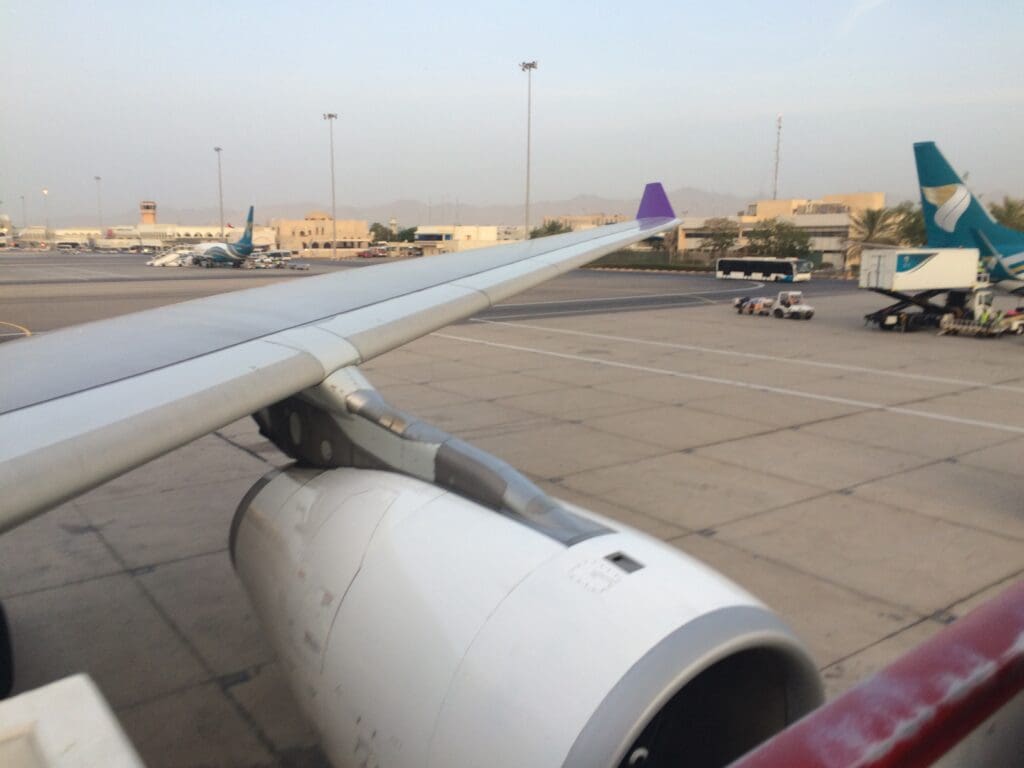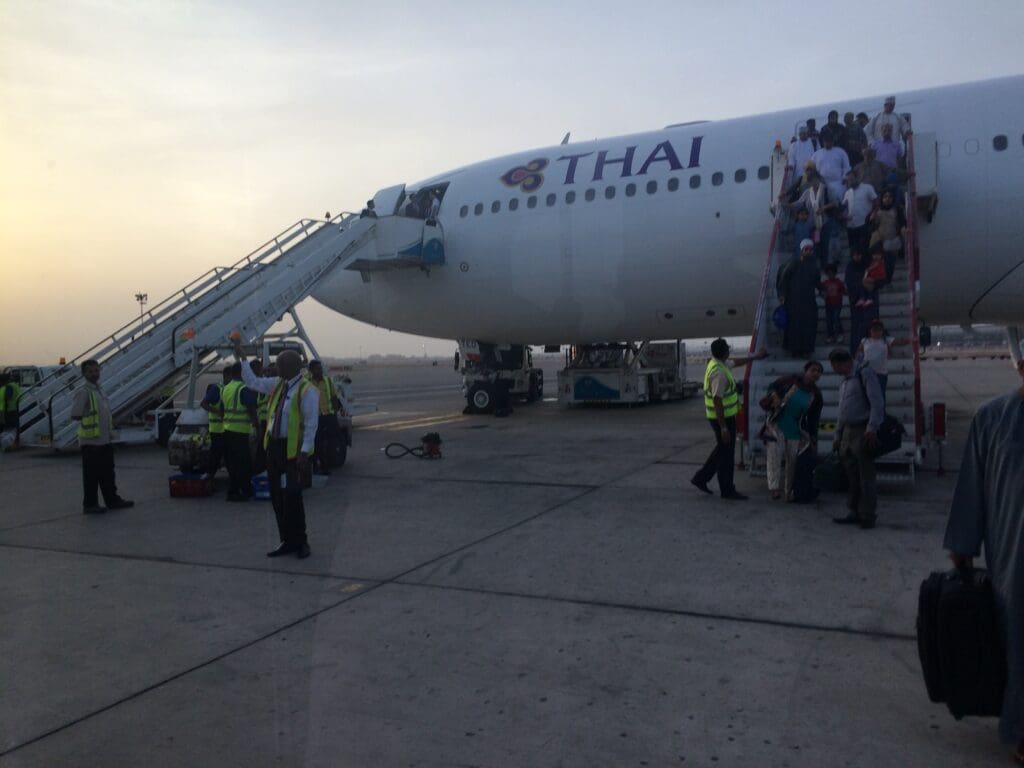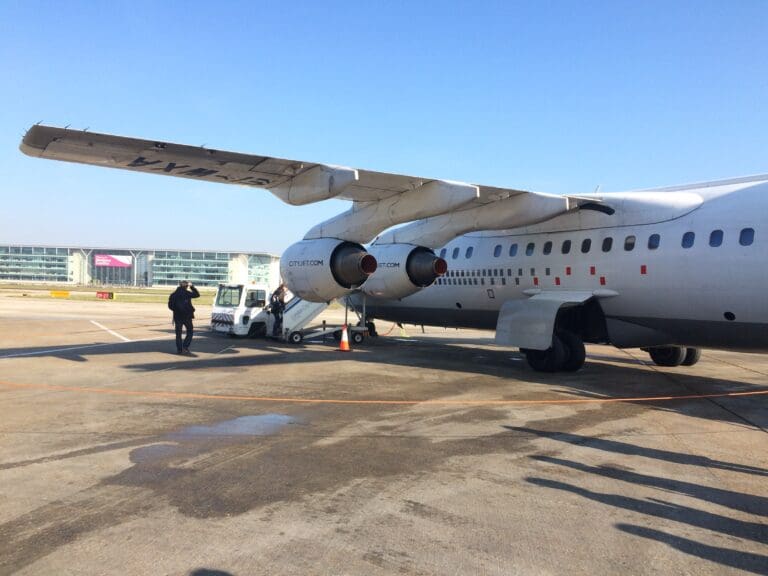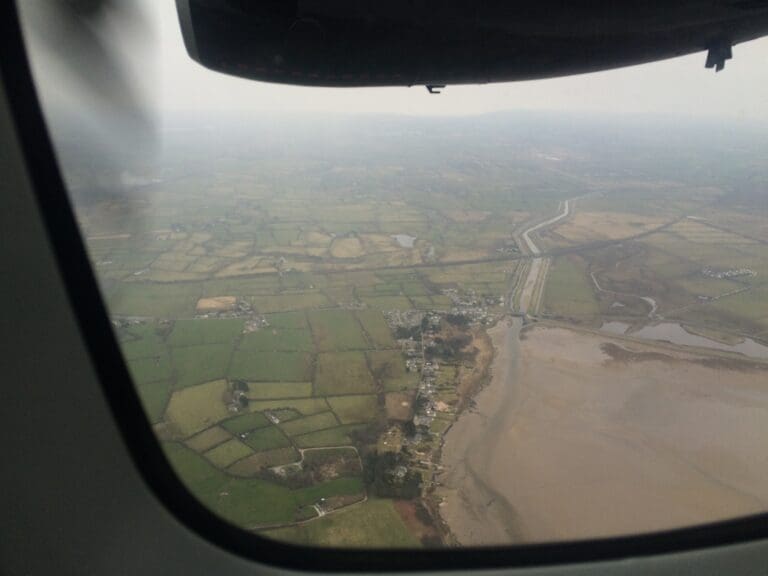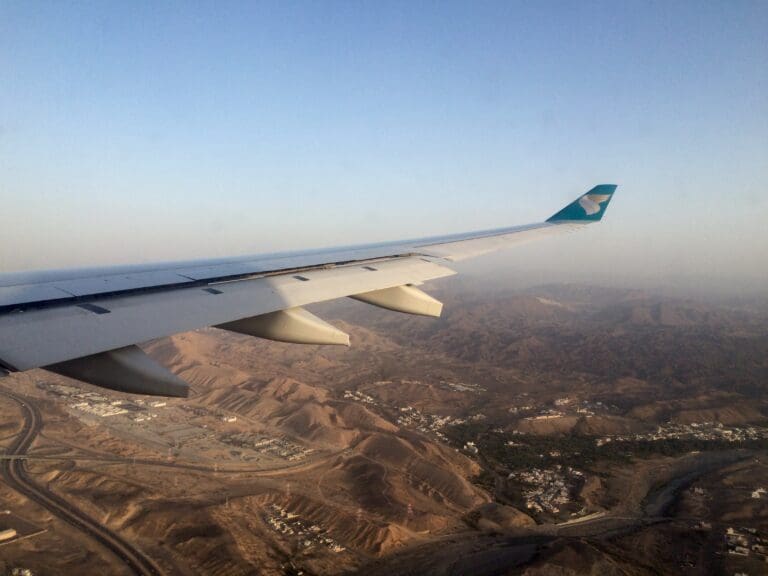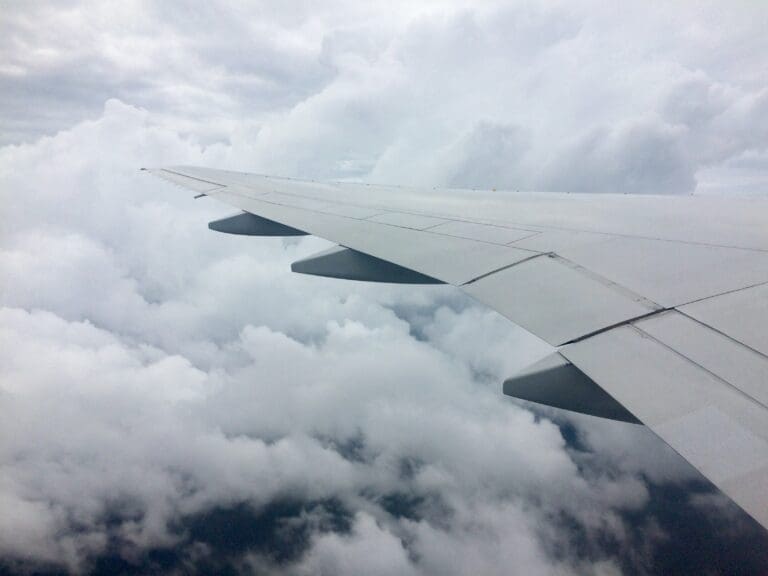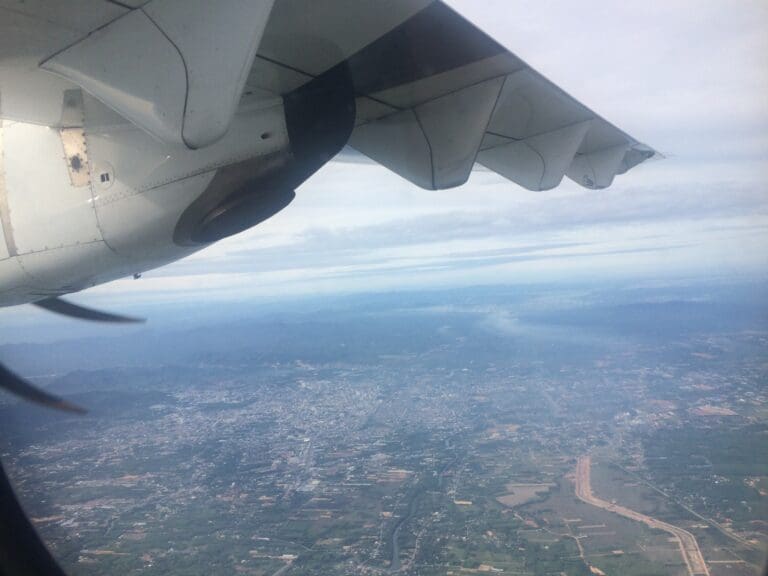A Thai A330 Adventure: Bangkok to Muscat with a Stop in Pakistan
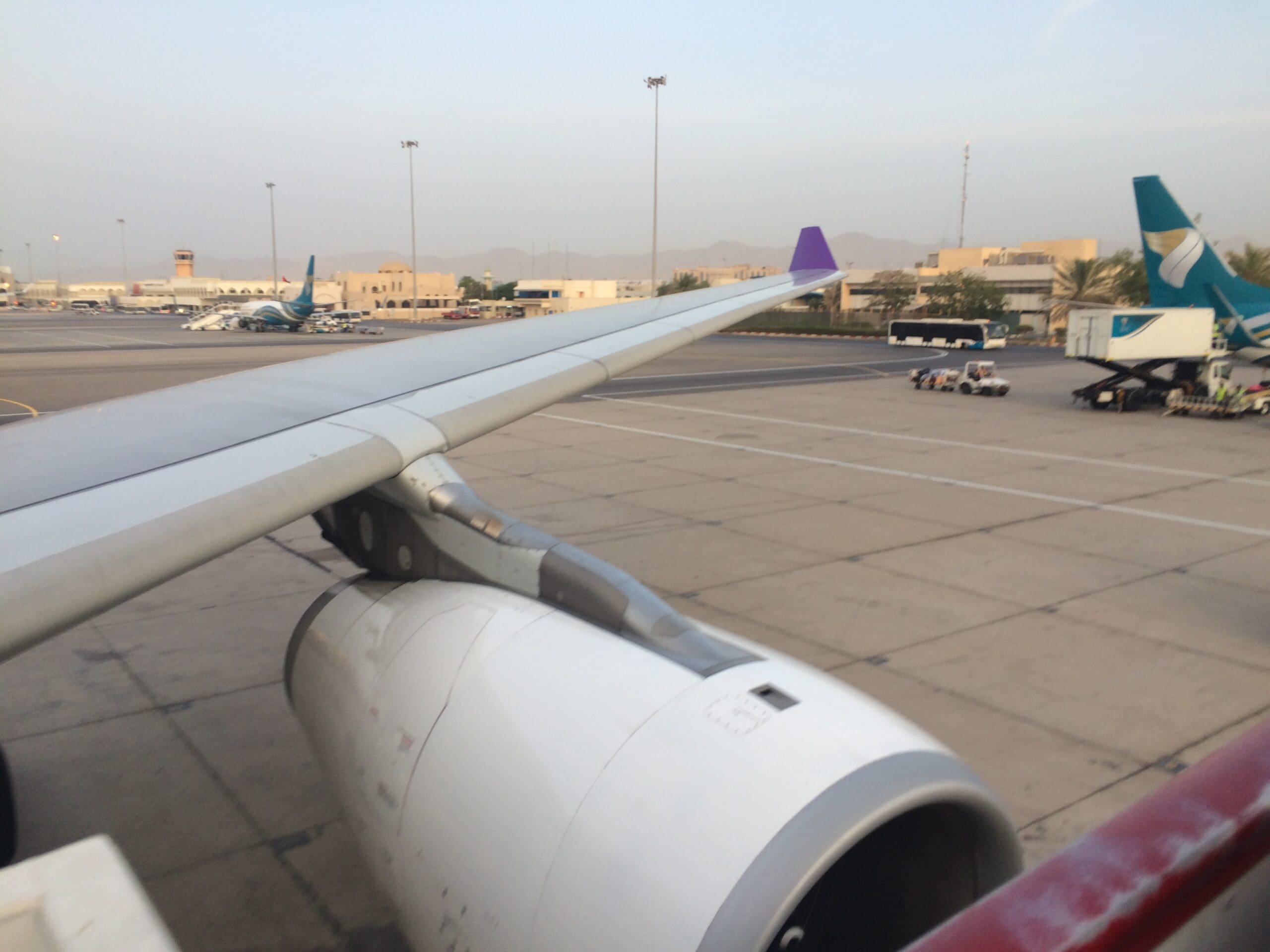
Background
The route between Bangkok and Muscat is relatively well served, with Oman Air offering daily flights departing each morning and operated by their new Boeing 787-8 Dreamliners. Meanwhile, Thai Airways operate Airbus A330 services between Bangkok and Muscat which make a shortstop in Karachi whilst Thai AirAsiaX operate three weekly flights with their Airbus A330-300s from Don Muang Airport. Having flown to Thailand on Oman Air and considering that I had never flown on an international Thai Airways service, I opted to take Thai Airways back to Muscat.
The Journey
After a short yet enjoyable early morning Malindo Air flight up from Kuala Lumpur, I arrived at Bangkok Don Muang Airport at 0815. In spite of having plenty of time between flights, long immigration queues following my arrival meant that it was already well past 0900 by the time I arrived in Don Muang’s landside area. Those connecting between Bangkok’s two airports are faced with little choice other than to take a taxi or a ride on the direct shuttle bus that operates between the two. Fortunately, the bus is free for those holding a ticket departing from either airport. Once I had showed my ticket from Suvarnabhumi Airport to the ticket inspector standing at the airport bus stop, I boarded the bus which departed with only a handful of passengers around ten minutes later. Despite having read Bangkok traffic horror stories online, I was pleased to find that traffic levels at that time in the morning were far from the chaos that most people had described and I arrived at Suvarnabhumi with plenty of time to spare. I had checked in online the night before, upon doing so I found out there were no window seats available however the closest I could get was 48K, an exit seat lacking a window.
Being a relatively new airport, Suvarnabhumi’s main terminal is bright and modern and whilst rather busy seemed to be modern and spacious. Upon arriving at the terminal, I headed straight for Thai Airways’ bag drop off area where I was able to drop my bag off and receive my boarding pass for the flight without any issue. As I had suspected, I was unable to check in for the second half of the journey to Heathrow with Oman Air although with airside transit desks at Muscat and a very long connection, this was in no way a problem. With plenty of time to spare, I decided to head up to have a look at the landside area’s observation deck located on the top floor of the terminal building. Unfortunately, as tends to be the case at the airport, the terminal’s structural design meant that few opportunities for photography were provided.
After a quick stop, I headed back down to security and immigration. Here I was greeted by the sight of long queues, however fortunately these moved along reasonably quickly and I didn’t have to wait long until I reached the airside area. Post security Bangkok is your standard major international airport with an abundance of shops, cafés and restaurants. There were plenty of seats available to sit and wait, fast and free WiFi, an abundance of plug sockets and the terminal appeared to be clean. Thus it was impossible for me to find anything negative to say about the terminal. Whilst the lack of photo opportunities from inside the terminal may be a little disappointing to those aviation enthusiasts. The airport does provide a constant stream of diverse movements from carriers both large and small from across the world.
With our departure time steadily approaching, at 1320 I decided to head down the airport’s C pier towards gate C10 located at the end of this. At that time, few passengers could be seen here with three of Thai Airways’ widebody jets waiting outside – a Boeing 747-400 about to commence a long journey North to Tokyo Haneda, a Boeing 777 waiting to fly south to Singapore and our Airbus A330 being readied for its flight west to Pakistan and Oman. As I neared the end of the pier, Airbus A330-343, HS-TEO could be seen waiting. Manufactured in Toulouse, the airframe made its first flight in April 2009 before being handed over to Thai Airways and flown to Bangkok the following month. Since its delivery, the aircraft has mostly operated short and medium haul flights across Asia wearing the name ‘Chutamat’. At the time of my flight, the aircraft had been involved in a single notable incident when a flight attendant was injured during a bout of turbulence on a flight from Fukuoka to Bangkok. In 2017 however, the aircraft was involved in another, seemingly serious sounding incident when the aircraft veered off the runway in Phuket following a flight from Hong Kong – although the aircraft was repaired and returned to service fairly rapidly after this.
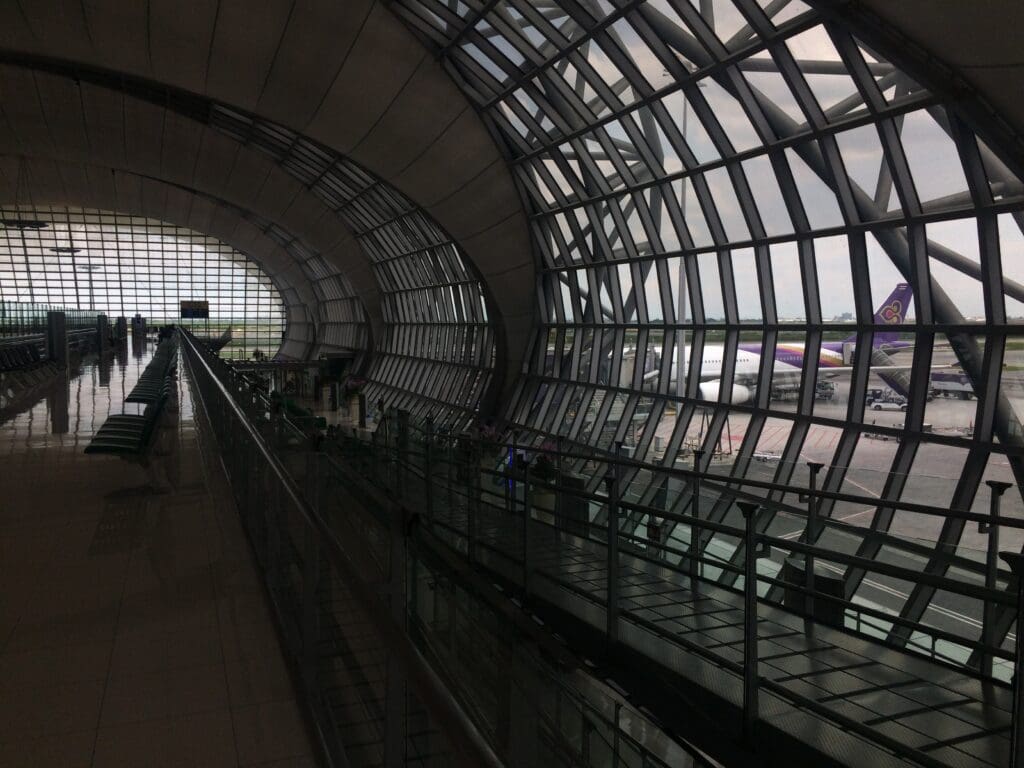
Upon arriving at the gate, I had my boarding pass scanned and entered the waiting area for the flight. Whilst I am not the world’s biggest fan of this arrangement aka having boarding passes scanned before being penned up in a waiting area for, on occasion a significant period of time, with the rare presence of toilets inside the gate waiting area, available seats and WiFi – my experience of this style at boarding in Bangkok was not too much of a problem. At first, I was only one of a very small number of passengers at the gate – however all of a sudden, an Airbus A330 sized load of passengers arrived at the gate within the space of around five minutes subsequently leaving this very full and a little cramped. Having checked the arrival boards at this time, I suspect that these passengers arrived off one of two of Thai Airways’ arrivals from Kuala Lumpur and Singapore.
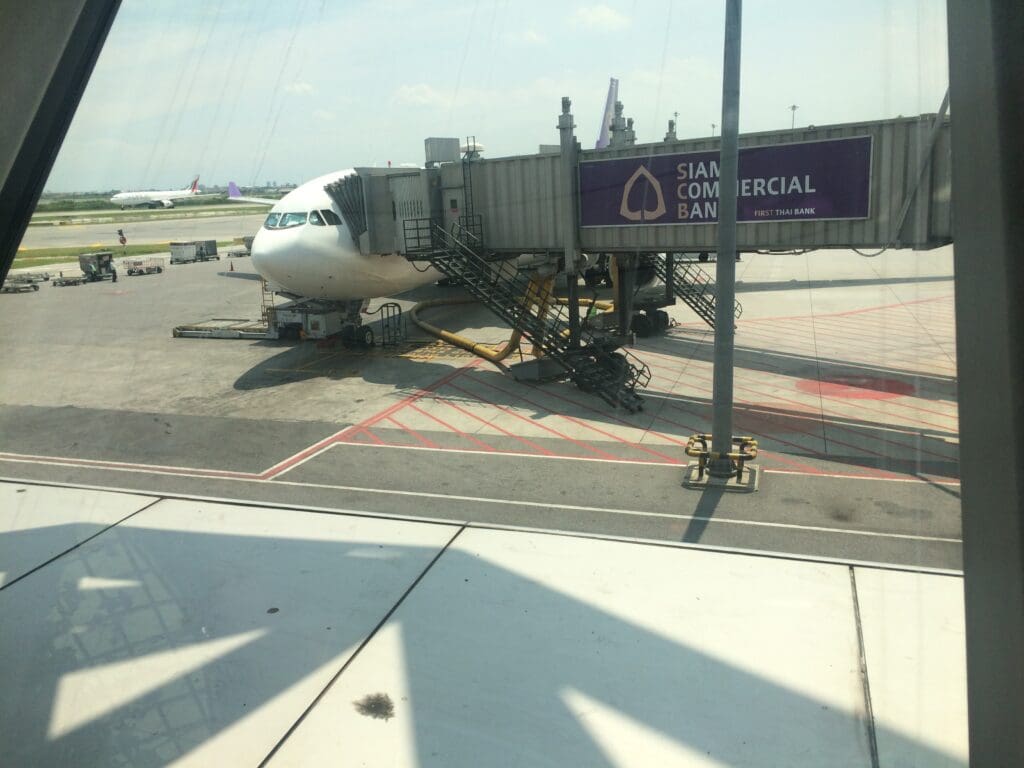
At 1345 boarding commenced and one by one passengers filtered onto the jetway towards the awaiting aircraft. Following a short wait, I stepped into the aircraft via the 2L door and was greeted in English by one flight attendant whilst another bowed as I headed through the galley to the second aisle. After a short wait whilst passengers attempted to store their oversized luggage in the overhead lockers I made it to the rear cabin and took my exit row seat in row 48. Unsurprisingly, I was soon joined by a passenger in the neighbouring seat, a proud Omani gentleman who spent the next few hours describing must-see Omani sights as well as the nation’s history. Despite the full load, boarding was completed within fifteen minutes and as I had suspected, the flight ended up being virtually 100% full. Approximately two thirds of those in economy seemed to be from Pakistan whilst a third appeared to be Omani with few passengers from anywhere else, including Thailand.
Since taking the flight many of Thai Airways’ Airbus A330s have been retrofitted with upgraded seats in both Economy and Business, all featuring modern PTVs and the latter fitted with lie-flat beds. However, at that time, for an aircraft that entered service in 2009, the cabin did seem to be somewhat old fashioned. The airline’s Airbus A330s are fitted with 36 seats in Royal Silk Business and 263 seats in the airline’s unimaginatively named economy class. As with the majority of Airbus A330 operators, Thai Airways operates these aircraft in a 2-4-2 economy configuration. Legroom wise, having an exit row seat I could not comment on this however, on the shorter second leg of the flight I managed to switch to a regular window seat and found the seat pitch to be acceptable but not the best.
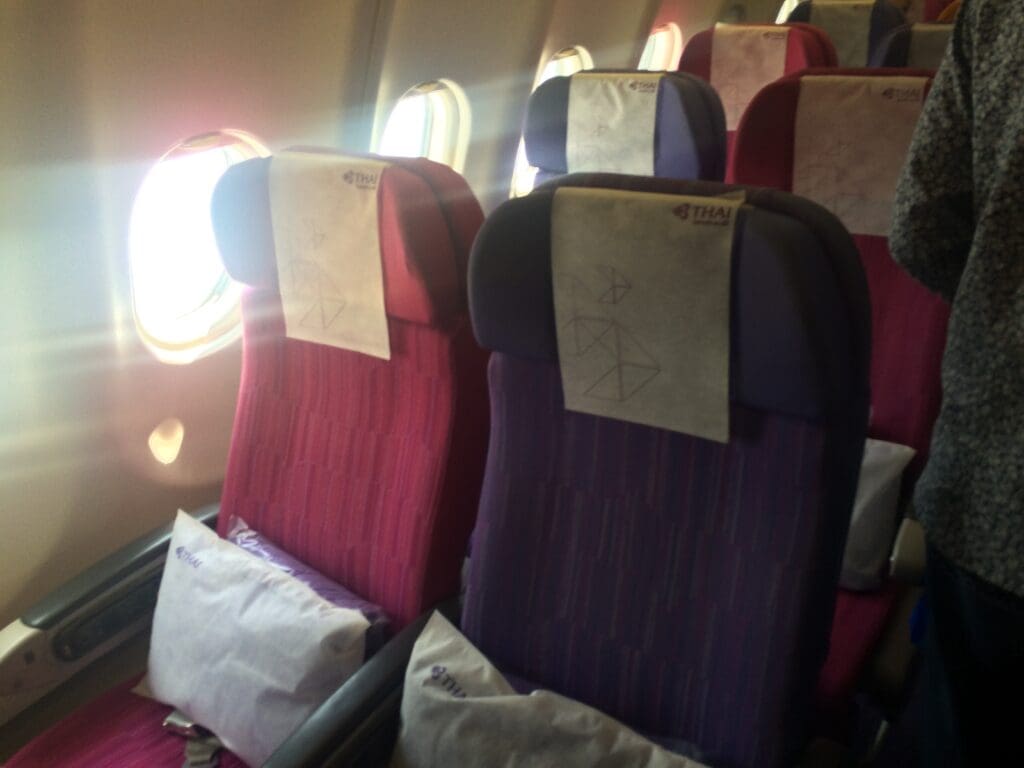
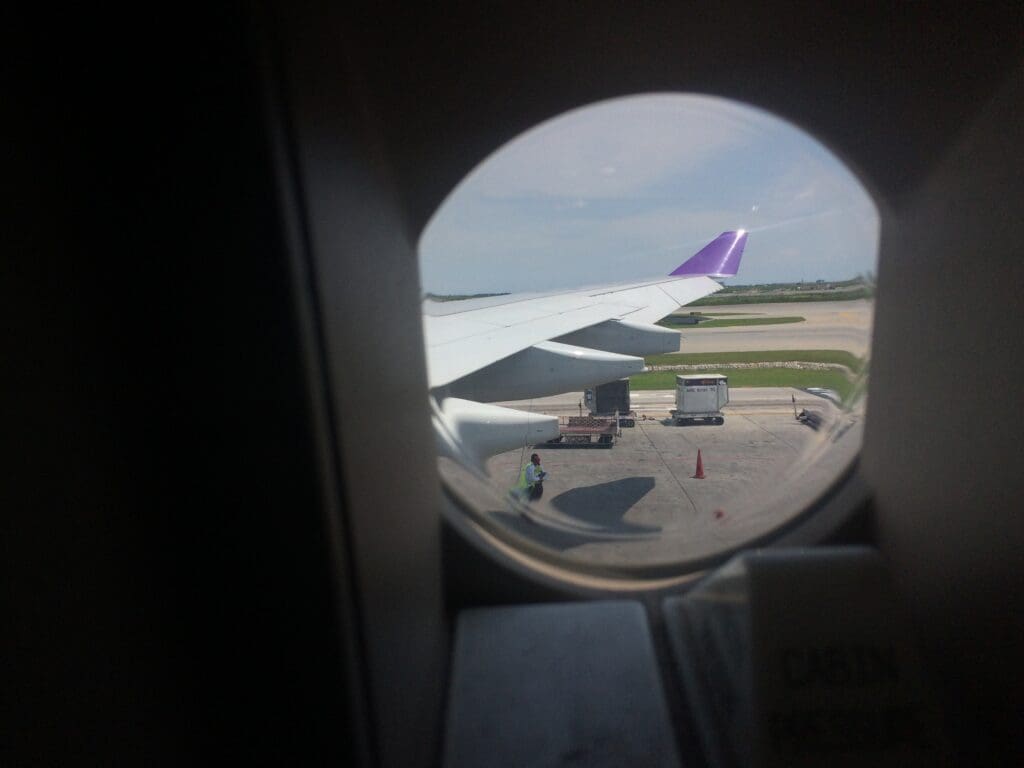
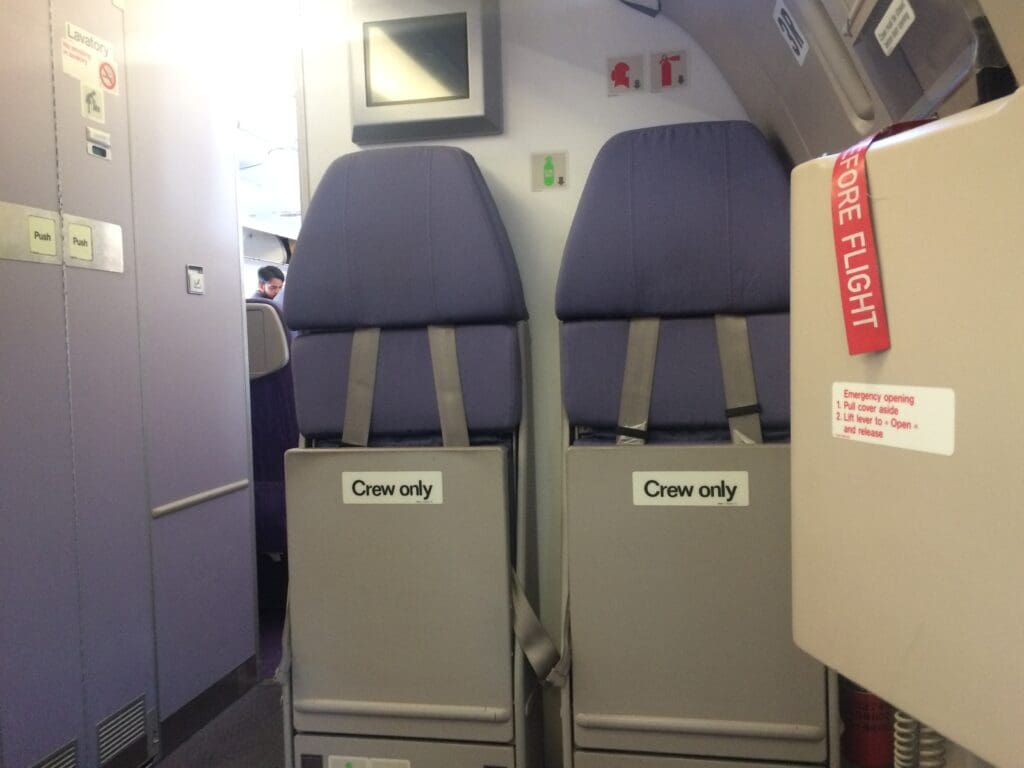
In Economy class, these seats were covered in blue-purple, orange and pink, creating a rather colourful cabin; these are gradually being replaced by more modern seats in a more sombre purple colour. Whilst those aircraft with the updated cabin feature modern touchscreen PTVs and USB ports, the features expected by many passengers these days were absent. Instead, the PTVs on the flight were old and lacked touchscreen functionality. Instead these could be controlled by a remote control in the armrest. Likewise, USB ports appeared to be totally absent onboard the aircraft. Upon boarding, pillows, blankets and standard economy class headphones had been placed on each seat. Each seat pocket contained a copy of the airline’s Sawasdee in-flight magazine, safety card and sick bag.
Once all passengers had boarded the aircraft, the purser conducted their welcome announcement in Thai and English where the usual thanks were given and we were advised of the 4H10 flight time. As well as this, the crew also conducted a warning, advising against pressing multiple buttons on the remote control at the same time to avoid the system crashing. Two minutes after our scheduled departure time, our aircraft pushed back and our two large Rolls Royce engines powered into life whilst inside the safety video played before the cabin crew conducted their final checks prior to departure.
Our taxi to runway 19L was conducted at a snail’s pace. After slowly edging along whilst aircraft in front of us departed one by one, eventually our aircraft headed onto the runway and began a gentle takeoff followed by what seemed like an equally shallow climb as we turned to fly northeastwards on a course that would see us cross Myanmar and out over the Indian Ocean. Despite a smooth climb, it was not until we reached our cruising altitude that seat belt signs were switched which was followed by many passengers jumping up to visit the bathrooms, which led to a small queue of passengers hovering around my seat.
Once the seat belt signs had been switched off, the crew passed around the cabin with hot towels which was followed by a round of peanuts and drinks. Whilst the flight lacked any paper menus in economy, passengers could access the menu for the flight via the IFE. The option for the main dishes consisted of a traditional Persian dish, Morgh polou chicken or deep fried prawns in a tamarind sauce with rice. Twenty minutes after the first round of service, I opted for the latter option and was handed a simple tray featuring my main course in a ceramic dish alongside sides consisting of a somewhat eclectic duck, pineapple and mozzarella salad as well as the usual bread roll with butter. Dessert consisted of a strawberry mouse and a packet featuring plastic eating utensils accompanied the main dish. Whilst in terms of quantity, the meal may appear to be a little lacking when compared to offerings on other full service airlines, I have absolutely no complaints regarding the quality of the dishes. A short while after receiving this, drinks were offered which to my surprise turned out to be the final drinks round of the flight. However, of course, the crew seemed more than happy to distribute drinks on request.
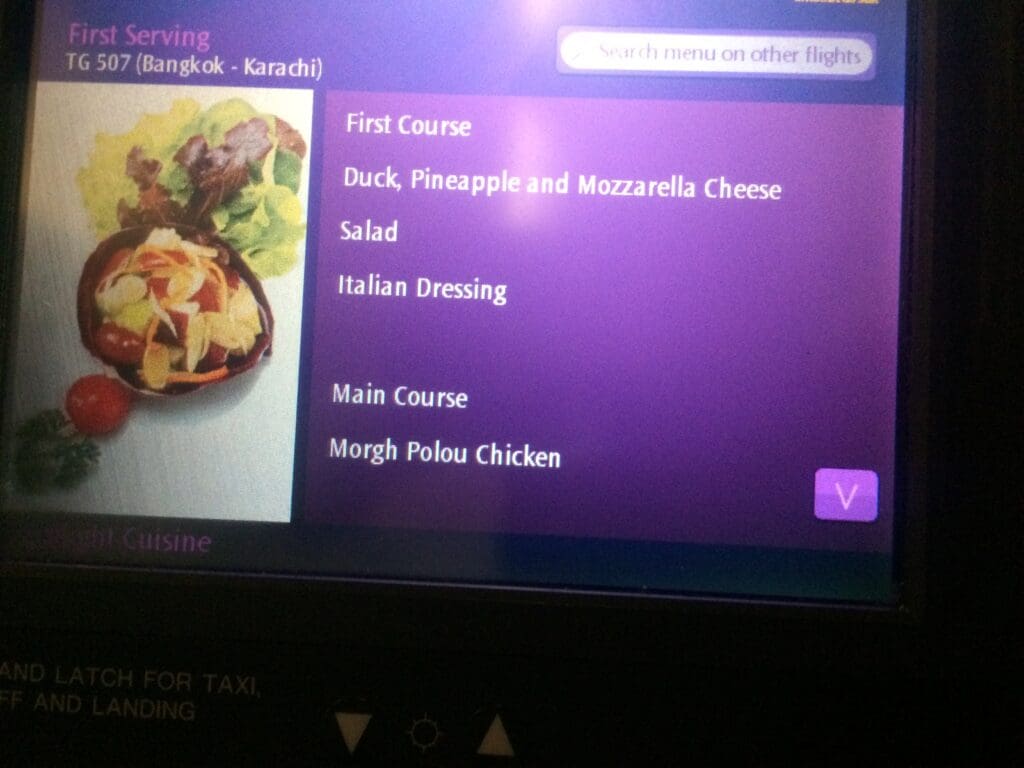
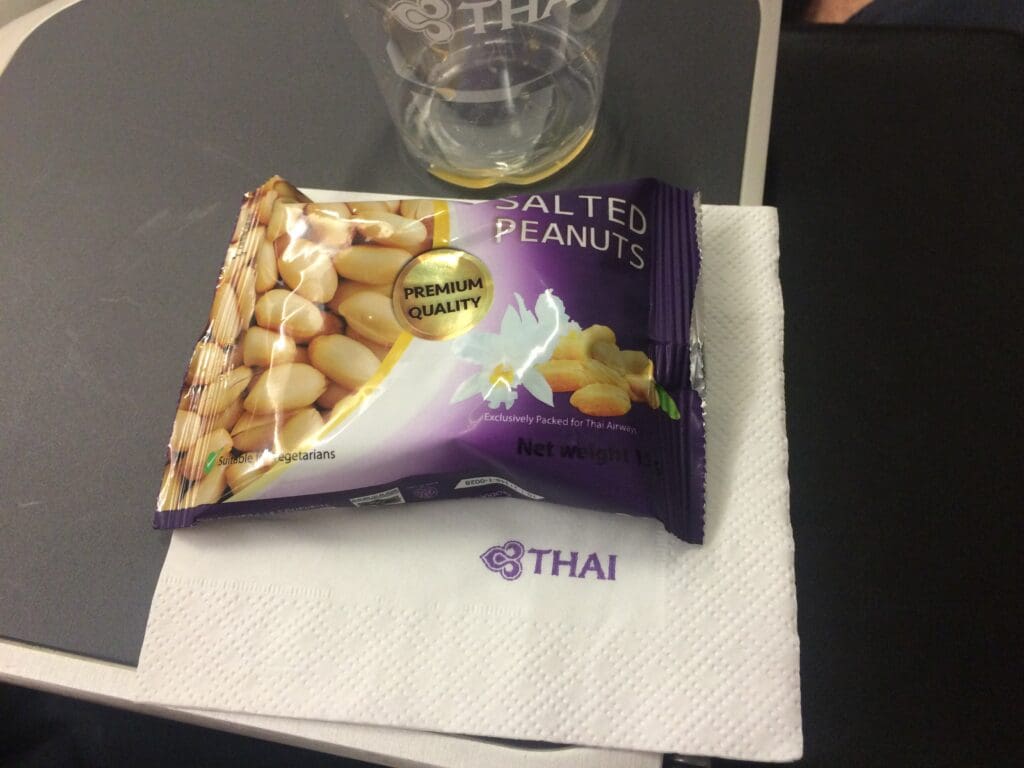
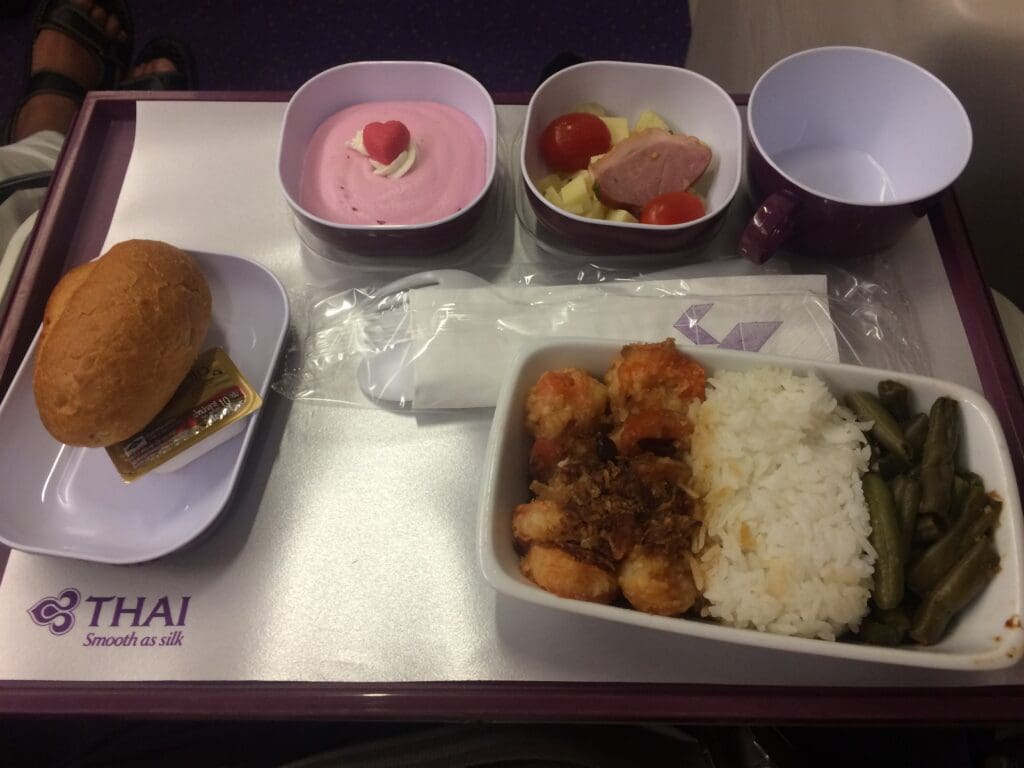
Whilst the old-style, low quality screen may give off the false impression of an overall poor system. Content wise, this was fantastic with a range of films and TV programmes both new and old from around the world. Having slept for around four hours in the previous 48 hours, I was rather tired and so once the cabin lights were dimmed following the lunch service, I, like many of my fellow passengers, drifted off to sleep as our flight progressed towards South Asia.

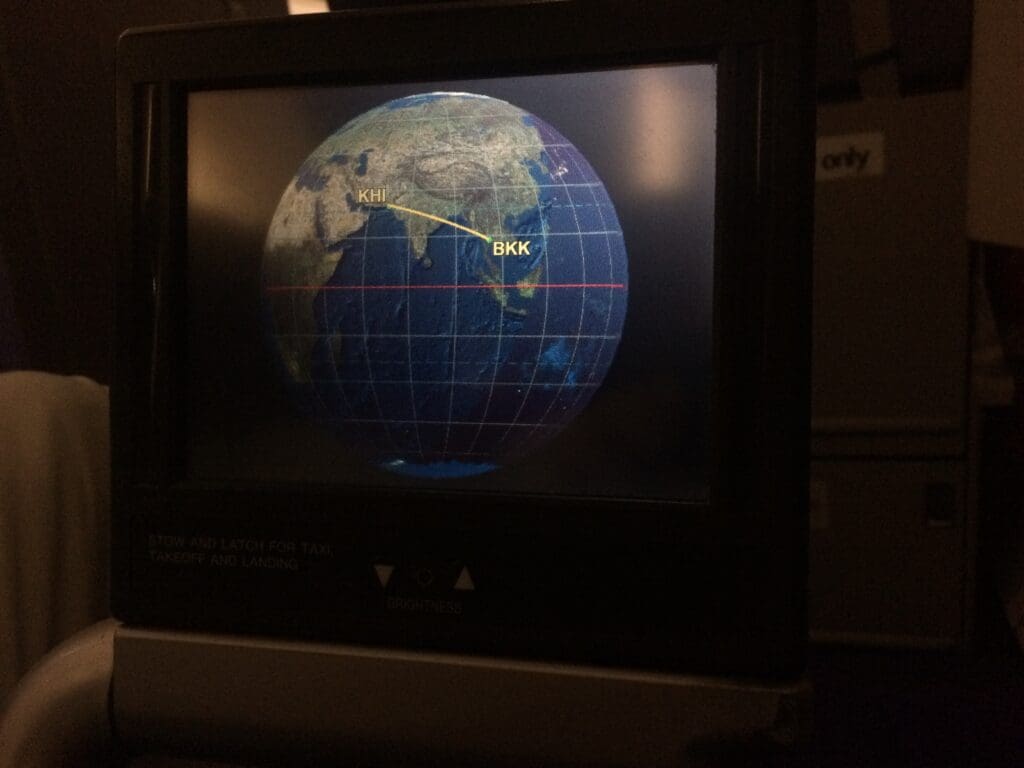
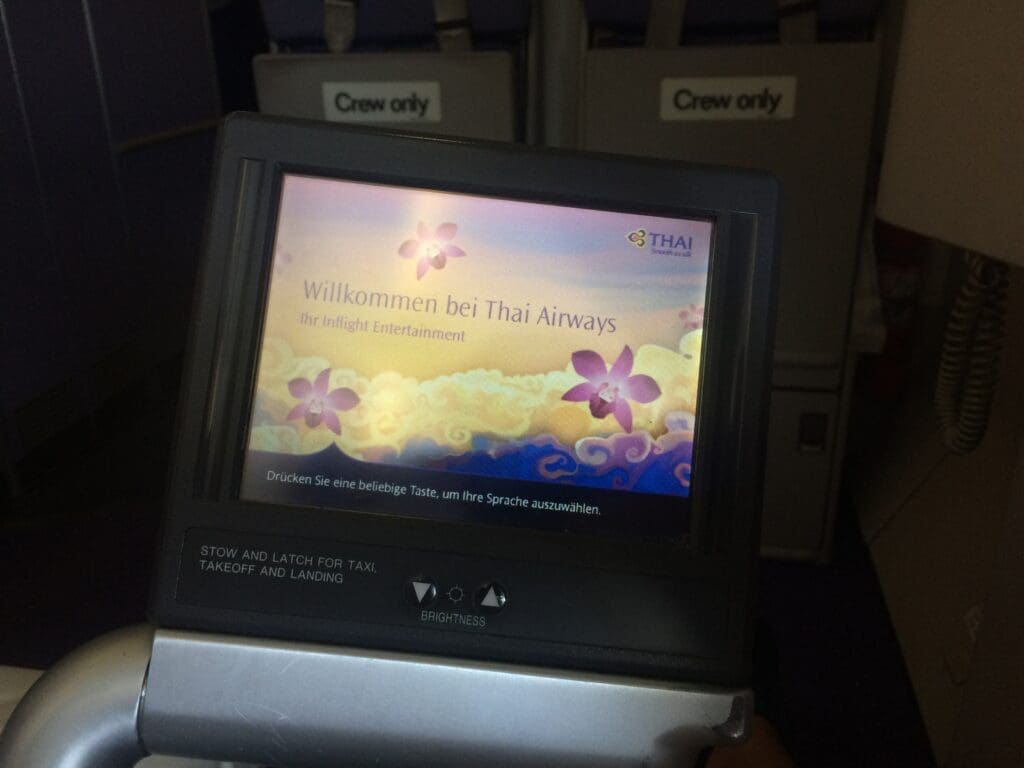
I spent the remainder of the flight sleeping and before I knew it we had crossed India and were beginning our descent into Karachi. We made a smooth approach down to the airport’s runway 25L before turning off, passing a wide variety of PIA, Shaheen and DHL aircraft before turning right into gate 25. Despite repeated calls from flight attendants for passengers to sit down it seemed like by the time we pulled into the gate most passengers for Karachi were already waiting to disembark. Following our arrival, the cabin crew made an announcement requesting all Muscat bound passengers to remain seated with their seat belts fastened for the 45 minute turnaround, the message ‘the toilets cannot be used at this time’ seemed to cause a sea of worried faces to flood the cabin. I was a little surprised that we were asked to keep our seatbelts fastened, most passengers (myself included) stood up to stretch their legs and the crew had no problem with this.
After being asked to identify our luggage in the overhead bins the security check was complete and cleaners came on board. Fed up with my virtually windowless row, I asked a cabin crew member whether it’d be possible to move seats, she informed me that there would be sixty empty seats on the next sector. Fortunately I was in luck and just before pushback I moved to seat 46K. Had I originated in Karachi, judging by my new seat there would’ve been no sign that this aircraft had already been travelling with a full load for four and a half hours as the seat area was spotless and blanket and pillow neatly placed on the seat. According to the welcome announcement, the flying time on this sector would be 1H20
After the safety video, the Airbus was pushed back and we soon commenced our short taxi to runway 25L, after waiting for a retro liveried PIA Airbus A320 to depart we made an unsurprisingly slightly more powerful takeoff than in Bangkok and headed upwards.
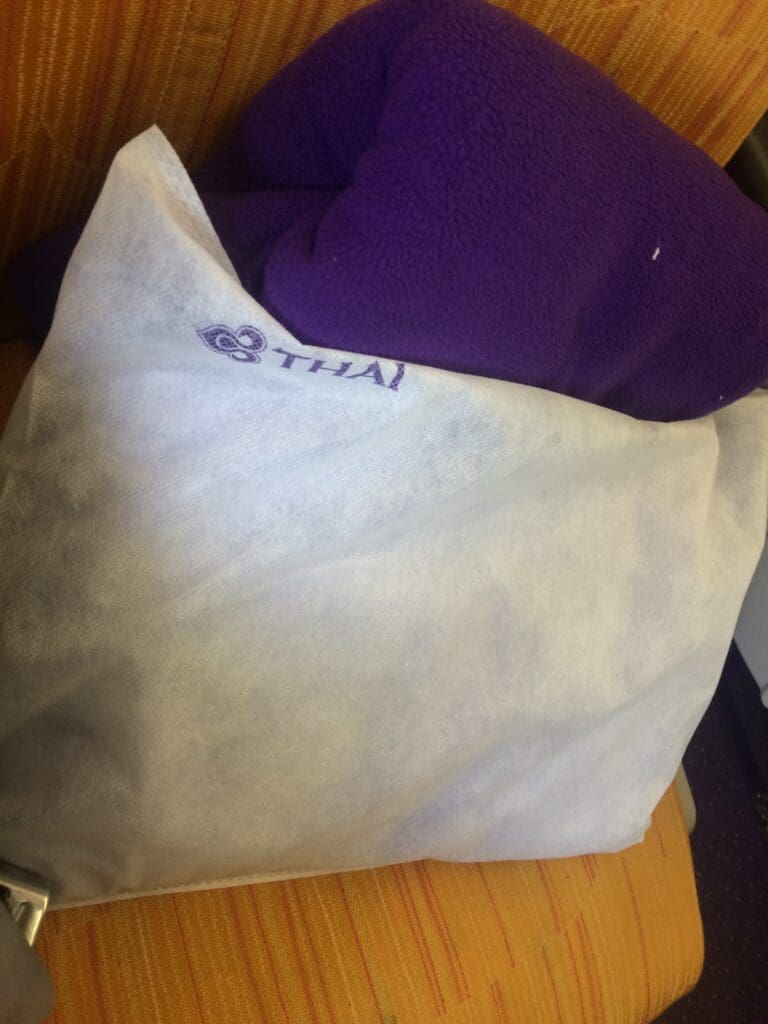

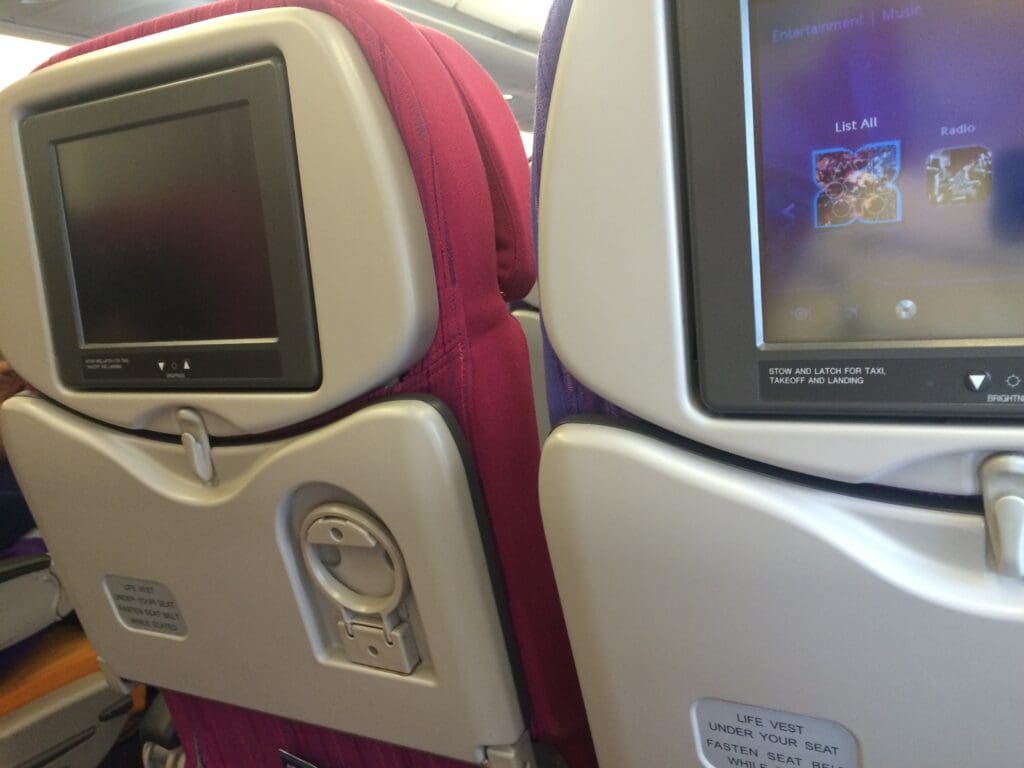


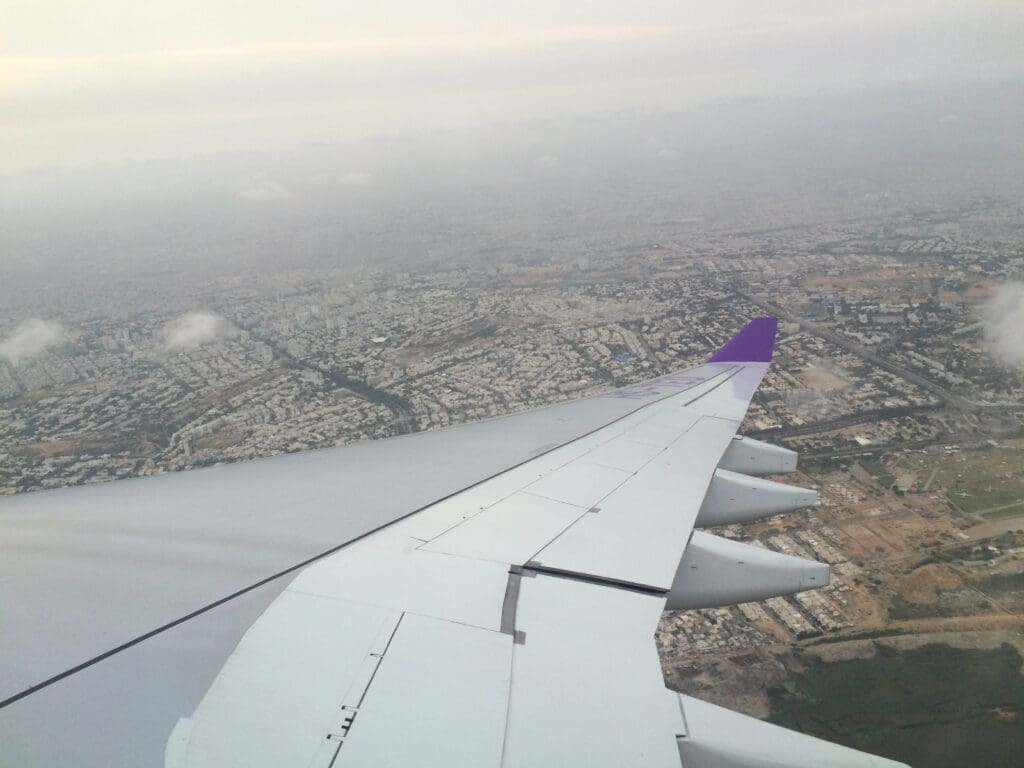
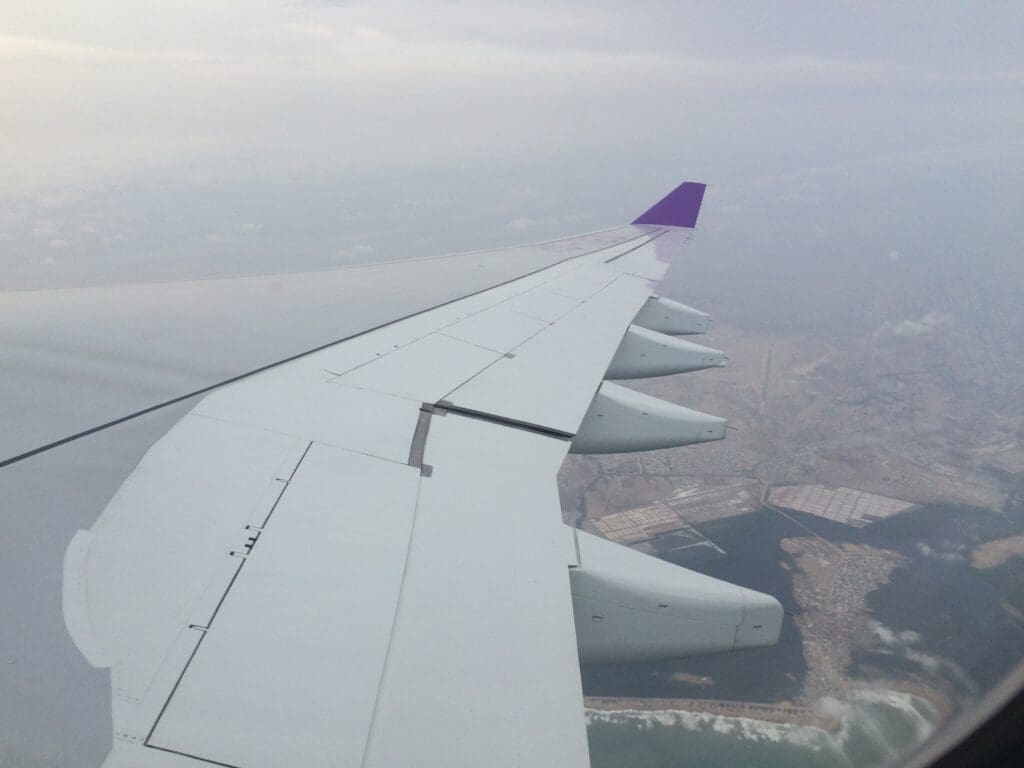
After departure we headed out over Karachi flying westwards. Shortly after takeoff an announcement informing passengers of the meal service. The meal on this flight would be a chicken ciabatta with salad. Five minutes later I was handed a paper box containing the above. The sandwich itself seemed to be almost identical to what I had been served on a Bangkok Airways ATR-72 flight from Phuket to Hat Yai around a month earlier. Not that this was a problem! In addition, extra warm bread rolls were offered however I decided to pass on these.
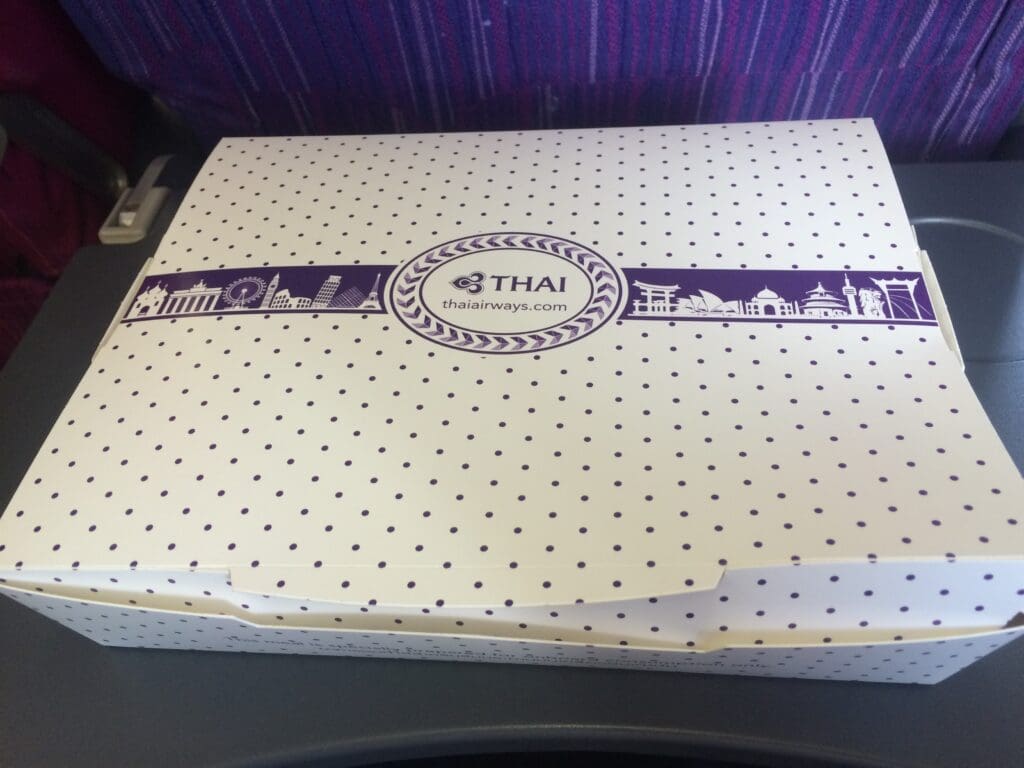
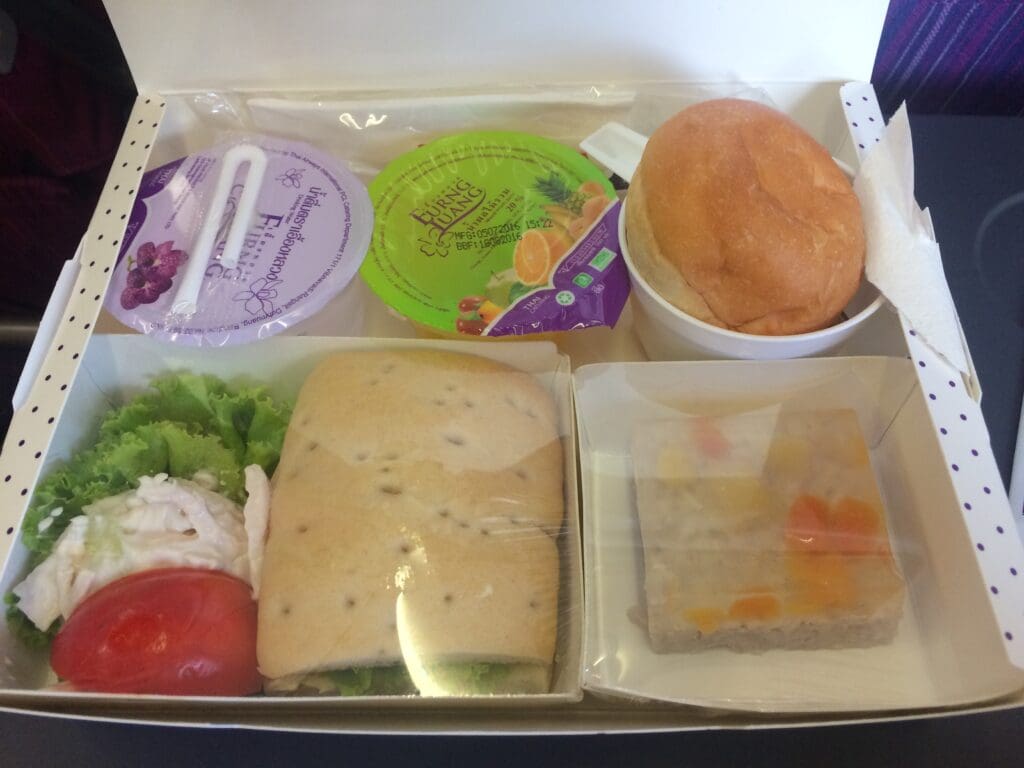
I spent the rest of the flight enjoying my window view and in what seemed like no time at all our short hop across the Indian Ocean was nearing its end and we began our descent into Muscat this took us over Seeb before turning eastwards onto finals for runway 08L.
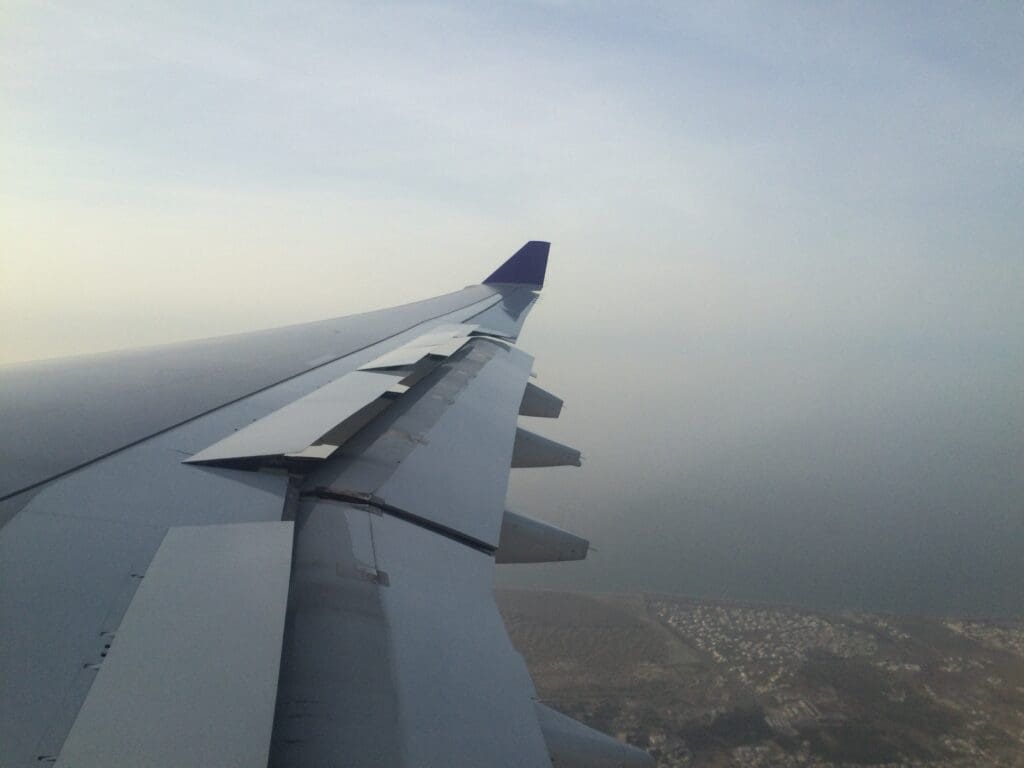
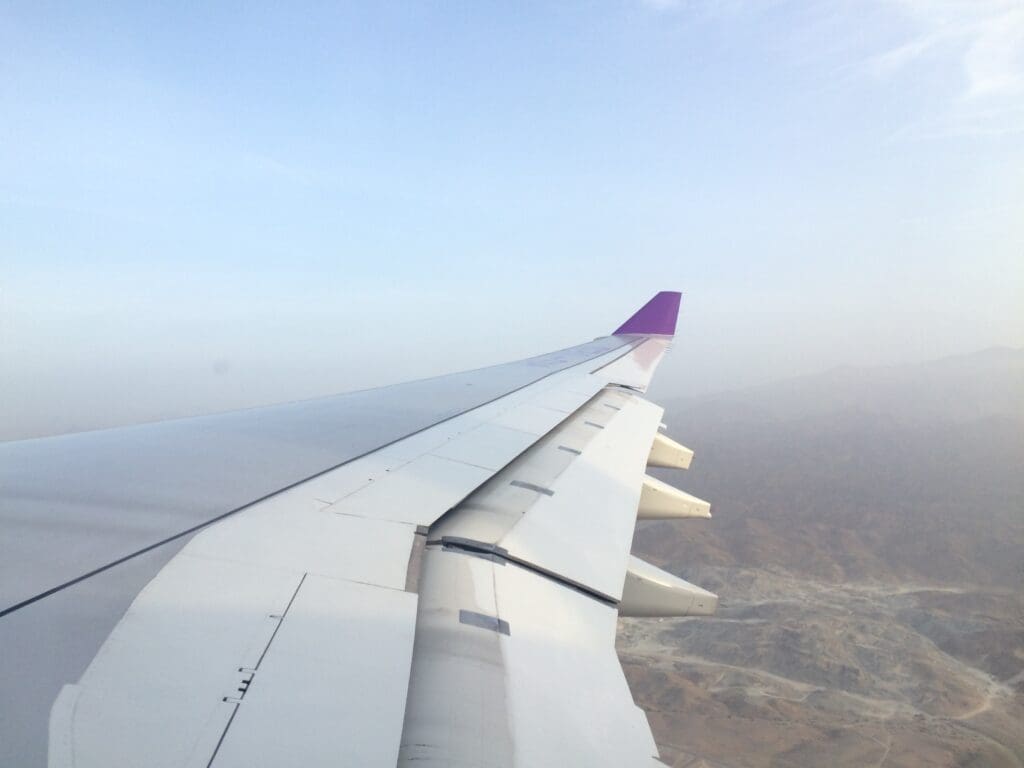
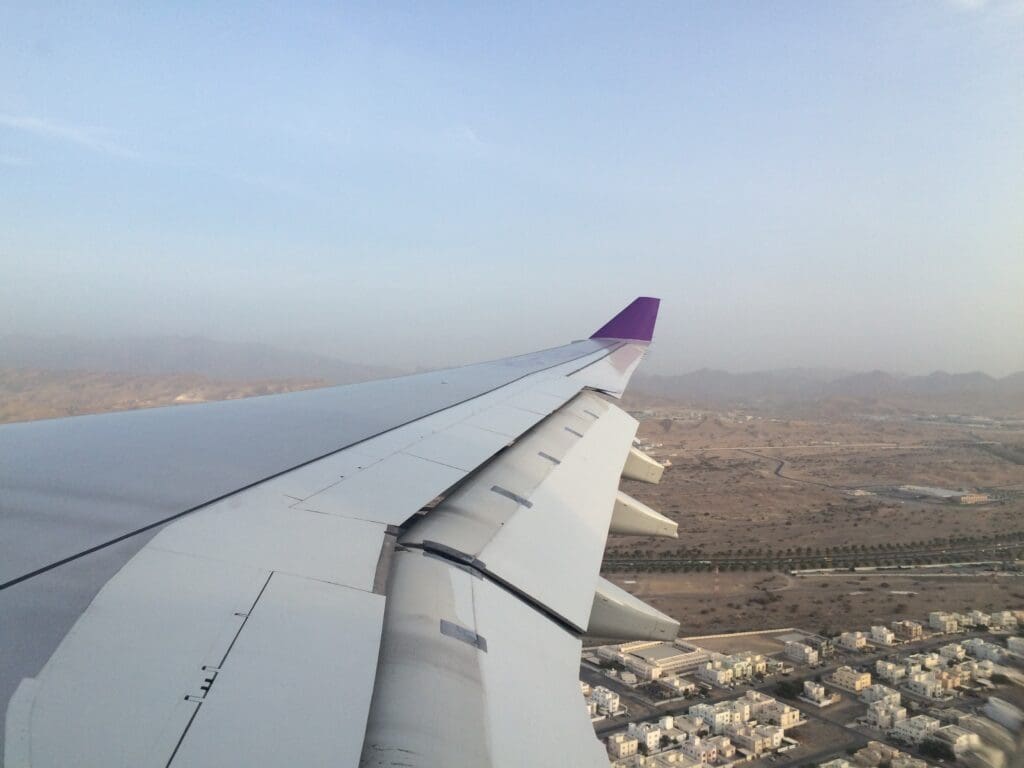
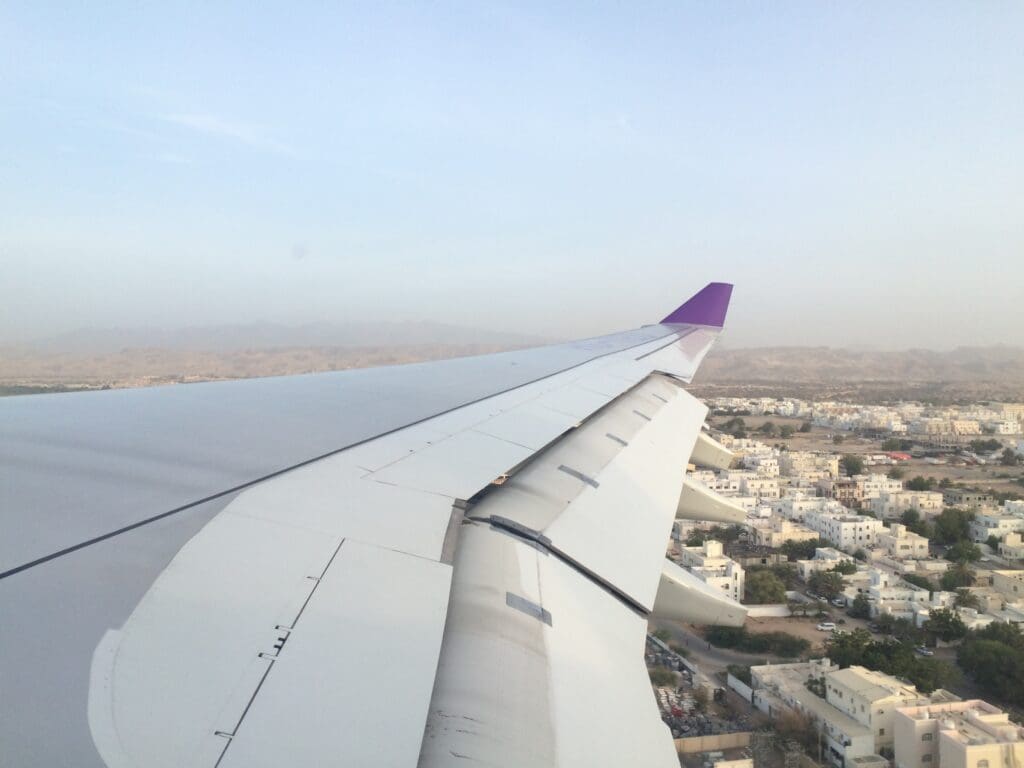
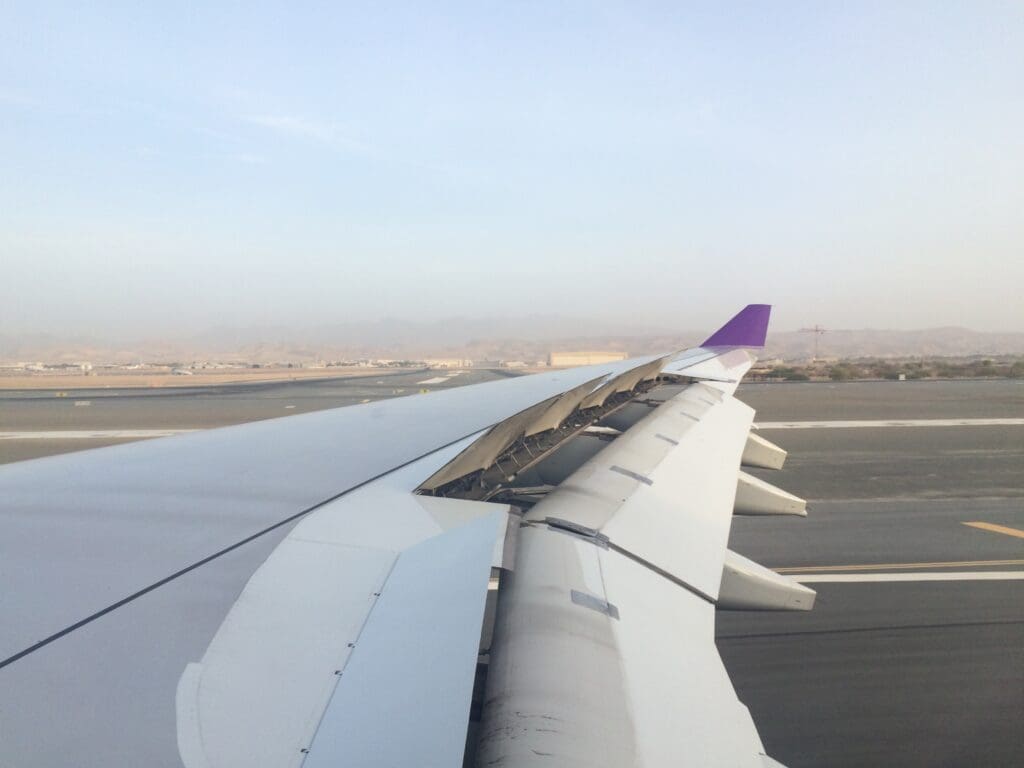
We landed 43 minutes ahead of schedule at 1817 and made our usual long Muscat style taxi to stand five. I have to say, I’m looking forward to the opening of the new terminal. Whilst the old terminal here isn’t bad, it is a little worn in fact it reminds me of the old Doha Airport minus the frequent long bus rides. At that time Muscat seemed to be an Airbus A330 haven with examples from Oman Air, Emirates and Thai AirAsiaX seen at the airport’s remote stands. Not too long after we arrived onto the stand, disembarkation began and we were bussed the short distance to arrivals.
